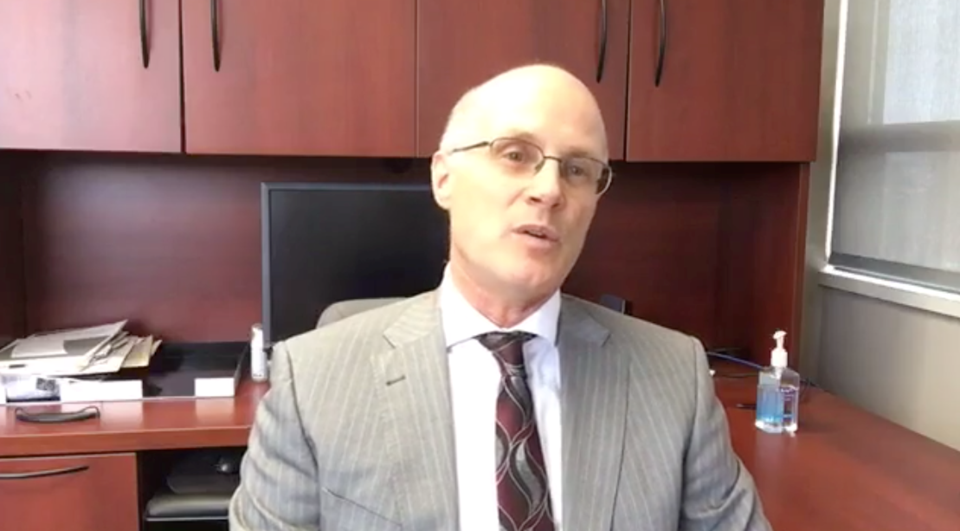Though the province of Ontario has released what it’s calling a “road map” to lifting pandemic controls, the Simcoe Muskoka medical officer of health says it’s not yet time to relax public health measures.
“It’s going to be prolonged,” Dr. Charles Gardner, medical officer of health for the Simcoe Muskoka District Health Unit, said of the province’s three-stage process for relaxing public health measures. “It’s premature to begin it now. We have plateaued, but we’re certainly not coming down (in new cases).”
In fact, Gardner expects there will be no traditional group celebrations this Canada Day.
“The risk associated with large gatherings would be significant,” said Gardner. “You’d have to have this completely under control … until we’ve managed to vaccinate the population there will be a need to restrict the size of crowds and have some form of physical distancing.”
The question of when to relax control measures in Ontario is one Gardner is familiar with. He is one of several regional medical officers of health who are part of the province’s Public Health Measures Table.
During the pandemic, he and the others in the group have been providing feedback on what measures to put in place and at what time in order to curb the spread of the virus. The table is led by Dr. David McKeown and he delivers the findings and advice of the regional medical officers of health to Ontario's chief medical officer of health, Dr. David Williams.
“It is a critically important task to figure out just how we can safely de-escalate these control measures,” said Gardner. “We need to relax the controls for people’s well-being, quality of life, the economy, people’s ability to make a living.”
But, Gardner said, he and others expect the virus to come and go in waves, and so too would public health measures intended to control the spread.
On Monday, the Ontario government announced a framework for re-opening the economy, but didn’t include a timeline.
Instead, the government will use a “range” of criteria to decide when and what to re-open. Specifically, today’s announcement stated there will be easing of public health measures when there has been a two-to-four-week decrease in the number of new daily COVID-19 cases.
Gardner said both the region and the province are seeing a flattening of the curve, but the virus is still spreading and infections are increasing, not decreasing.
“By no means are we actively on the downward slope,” said Gardner. “People need to stay the course to make sure we don’t lose control of the gains we’ve made.”
The doctor noted the doubling rate of the virus in the region (the amount of time it takes for the number of cases to double) is now 21.7 days, compared to 14.9 days one week ago.
Provincially, the doubling rate is now 17.7 days, compared to 12.2 days a week ago.
But beyond the spread of the virus, the government stated it wants to make sure there is capacity for a surge in patients should relaxed public health measures cause more spread.
Gardner, too, said it’s important to make sure the health-care system has capacity before relaxing control measures and potentially allowing the virus to spread again.
Part of the consideration will be the capacity of critical and acute care at hospitals in the province, and access to ventilators and personal protective equipment, or PPE. The province also wants to make sure public health units are on top of contact tracing (90 per cent of contacts reached within a day).
And, even with relaxed measures in place, the province still wants to make sure there is ongoing testing of suspected COVID-19 cases, especially in vulnerable populations.
“We need these triggers to put these controls back in place,” said Gardner. “We need to monitor (the virus) coming and going. As it declines as a wave we can relax those controls … knowing we could probably encounter it returning.”
When it comes to relaxing measures, the government plans to start by opening select workplaces with modified operations and opening outdoor spaces like parks. The government is also considering increasing the number of people allowed to gather (currently it is limited to five) and also having hospitals offer non-emergency surgeries and services again.
Stage two is the same as stage one, but with more businesses, larger gatherings, and more outdoor spaces.
Stage three proposes opening all workplaces “responsibly,” and further loosening restrictions on gatherings.
“If you stopped all control measures (at the same time) you would end up with a big surge,” said Gardner. “This really speaks to the fact that we’re in this for the long haul for this virus.”
The Simcoe Muskoka District Health Unit reported 24 new cases since Friday, and one more outbreak at a Barrie long-term care facility. The province reported 424 new cases today, 437 on Saturday, and 476 on Sunday.



